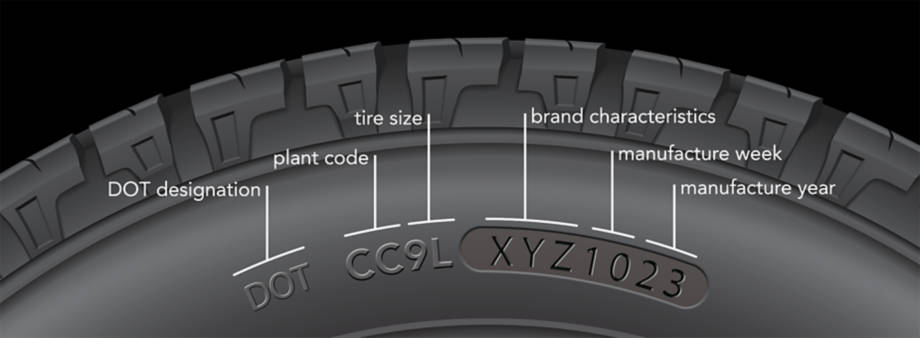The U.S. Department of Transportation (DOT) requires every tire manufacturer to provide a standard tire identification number or code. This helps drivers like you learn a lot of information about your rubber with a quick glance at your tire date code.
The DOT code consists of the manufacturer's plant code, the tire size, brand and the week/year the tire was made.
The DOT number is stamped on both sides of the tire sidewall and can be found by looking for the DOT designation on the sidewall. The other sidewall of the tire will have the initials DOT and the manufacturer's plant code.
To help you interpret the tire DOT code, we'll work from the example below and break down what each section of the code means. Keep in mind, the first three sections of the code are typically just for use by the manufacturers. For most drivers, the most helpful digits are the tire date codes at the very end.
Example DOT Tire ID Number
Using "DOT CC9L XYZ 1023," we'll break down each section of the ID and what it means:
- CC:
The first two characters in the tire code represent the manufacturer plant. Not only does this indicate the manufacturer, it tells the precise plant where the tire was built.
- 9L:
The next set of characters represent the tire size.
- XYZ:
The next three characters represent the brand characteristics. These are significant characteristics about the tire as determined by the manufacturer.
- 1023:
The last set of characters is the tire date code and it tells you the week/year your tires were manufactured. Tires produced after January 1, 2000 will have a four-digit date code at the end of the DOT number, as displayed in our example.
The first two digits represent the week of production and the last two digits represent the year. So, the number in our example, 1023, indicates that the tire was produced in the 10th week of the year 2023.
Now that you know all about how your tire DOT code works, be sure to register your tires!
DOT Identification Prior to 2000
Prior to the year 2000, the date code was restricted to a three digit number representing the week (first two digits) and the year (one digit) of production. For example, if the last three digits are 439, the tire was produced in the 43rd week of 1999.
That said, your tire's age is critical when it comes to tire safety. If your tires are this old, they'll need to be replaced ASAP. We recommend considering tire replacement at six years of age. And for your safety, we won't service tires aged 10 years or older.
If you have any questions or require any assistance, stop by any of our America's Tire locations and we'll get you taken care of! Customers who buy and book online save time in-store!
